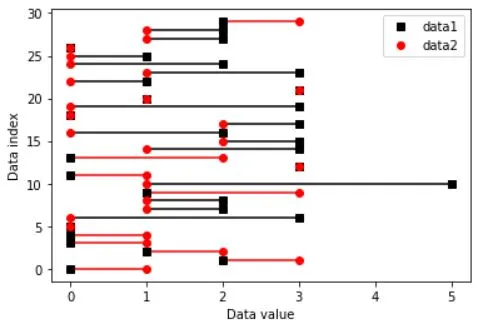Signed-rank testing quick dive.
Welcome to our extensive guide on the Wilcoxon Signed-Rank test using Python - where statistics meet coding. If you're looking to construct a robust understanding of this non-parametric statistical hypothesis test, you've arrived at the right place. Whether you are a Python novice or an incisive data scientist, our guide offers a step-by-step walkthrough to effectively use the Wilcoxon signed-rank test. We bridge the gap between statistical knowledge and computational execution, augmenting your skills in data analysis by ensuring you become proficient in implementing this critical statistical tool using Python.

Python Knowledge Base: Make coding great again.
- Updated:
2025-12-31 by Andrey BRATUS, Senior Data Analyst.
Generating initial data for Wilcoxon signed-rank test:
Wilcoxon signed-rank test using the Python scipy library:
Interpreting the Results of the Wilcoxon Signed-Rank Test.
Advantages and Limitations of the Wilcoxon Signed-Rank Test.
Conclusion.
Before we dive into the wonderful world of the Wilcoxon Signed-Rank Test, let's take a moment to appreciate the sheer power it holds. This test, my friend, is a fancy statistical tool that helps us compare two related samples. Yes, it's like the Sherlock Holmes of hypothesis testing, sniffing out any differences between those samples.
Now, the Wilcoxon Signed-Rank Test has its fair share of use cases. Picture this: you want to test if a new weight loss program actually works. You collect data from participants before and after the program and want to analyze if there's a significant change. Ta-da! The Wilcoxon Signed-Rank Test is here to save the day by analyzing the differences within each pair of measurements.
Ah, assumptions, those sneaky little things. Every statistical test has them, and the Wilcoxon Signed-Rank Test is no exception. It assumes that the differences between the paired measurements follow a continuous distribution (no categorical data, please!) and that the differences are symmetrical (no skewness allowed!). So, if your data meets these assumptions, you're good to go.
Now that we've grasped the basics of the Wilcoxon Signed-Rank Test, it's time to put on our coding hats and see how this test can be performed with Python. Get ready, my friend, because we're about to embark on a journey of setting up the environment, preparing the data, conducting the test, and analyzing the results. Exciting, right?
But hold your horses, we can't jump to conclusions just yet. In the next section, we'll decode the results of the Wilcoxon Signed-Rank Test like detectives examining a crime scene. We'll learn how to interpret the test statistic, analyze the p-value, and draw logical conclusions that would make Sherlock Holmes proud.
Just like any other statistical test, the Wilcoxon Signed-Rank Test has its pros and cons. On the upside, it doesn't require any assumptions about the distribution of the data, making it robust and flexible. However, it does have its limitations, such as the inability to handle missing data and the need for a sufficient sample size to yield accurate results. Like every superhero, it has its kryptonite.
The Wilcoxon signed-rank test is often also called non-parametric t-test.
The word “non-parametric” in this case means that you know the population data does not have a normal distribution.
Wilcoxon signed-rank test features:
-Nonparametric alternative to the one- or two-samples t-test.
-Mainly used when the data do not conform to the normality assumptions.
-Tests for differences in medians instead of differences in means because mediand insensitive to outliers.
There are two slightly different versions of the test used:
- The Wilcoxon signed rank test compares your sample median against a hypothetical median.
- The Wilcoxon matched-pairs signed rank test computes the difference between each set of matched pairs,
then follows the same procedure as the signed rank test to compare the sample against some median.
import matplotlib.pyplot as plt
import numpy as np
import scipy.stats as stats
## generate the data
N = 30
data1 = np.random.poisson(1.4,N)
data2 = np.random.poisson(1,N)
colors = 'kr'
for i in range(N):
plt.plot([data1[i], data2[i]],[i, i],colors[int(data1[i]<=data2[i])])
plt.plot(data1,np.arange(N),'ks',markerfacecolor='k',label='data1')
plt.plot(data2,np.arange(N),'ro',markerfacecolor='r',label='data2')
plt.ylabel('Data index')
plt.xlabel('Data value')
plt.legend()
plt.show()

t,p = stats.wilcoxon(data1,data2)
print('Wilcoxon z=%g, p=%g'%(t,p))
OUT: Wilcoxon z=74, p=0.046319
Once you have conducted the Wilcoxon Signed-Rank Test, it's time to interpret the results. Let's dive into the key points you need to understand: the test statistic, the p-value, and drawing conclusions from the results.
First, let's talk about the test statistic. The test statistic in the Wilcoxon Signed-Rank Test represents the strength and direction of the relationship between the two paired samples. It measures the extent to which one sample is greater or smaller than the other. The sign of the test statistic indicates the direction of the relationship, while the magnitude of the test statistic reflects the strength.
Moving on to the p-value. The p-value is a crucial element in hypothesis testing. It measures the probability of obtaining the observed data, or more extreme, if the null hypothesis is true. In simpler terms, it tells us how likely it is that the observed differences between the paired samples were due to chance alone. A smaller p-value suggests stronger evidence against the null hypothesis.
Lastly, let's discuss drawing conclusions from the results. Based on the test statistic and the p-value, you can make informed decisions about your hypothesis. If the test statistic is significant and the p-value is smaller than your predetermined significance level (usually 0.05), you can reject the null hypothesis. This indicates that there is likely a significant difference between the paired samples. On the other hand, if the p-value is greater than the significance level, you fail to reject the null hypothesis, suggesting that there is not enough evidence to support a significant difference.
Now that you have a good understanding of how to interpret the results of the Wilcoxon Signed-Rank Test, you can confidently draw conclusions and make informed decisions based on your data. Remember, statistics is all about uncovering the hidden stories behind the numbers. So, put on your detective hat and analyze away!
Advantages of the Wilcoxon Signed-Rank Test:
One of the major advantages of the Wilcoxon Signed-Rank Test is its ability to handle non-normally distributed data. Unlike parametric tests, this test doesn't require the data to follow a specific distribution, making it more flexible in real-world scenarios. Another advantage is that it is a non-parametric test, meaning it makes minimal assumptions about the data. This makes it suitable for situations where the normality assumption is likely to be violated or when dealing with ordinal or interval data. Additionally, the Wilcoxon Signed-Rank Test is robust to outliers, making it more reliable even in the presence of extreme values. Considering its practicality, it is great that this test doesn't rely on a larger sample size, making it suitable for studies with limited data.
Limitations of the Wilcoxon Signed-Rank Test:
While the Wilcoxon Signed-Rank Test has its advantages, it also has some limitations to keep in mind. One limitation is that it can only be used for paired samples, limiting its applicability in certain situations. Additionally, this test is restricted to assessing the directionality of differences. It doesn't provide information on the magnitude or effect size, which may be important for interpreting the practical significance of the results. Another limitation is its reduced statistical power compared to parametric tests, especially when the data does follow a normal distribution. Finally, like any statistical test, the interpretation of results should consider the context and the specific research question at hand. So, while the Wilcoxon Signed-Rank Test is a valuable and versatile tool, it's important to understand its limitations before using it in your analysis.
So, we've reached the end, folks! Just a quick recap of what we've covered in this comprehensive guide on the Wilcoxon Signed-Rank Test with Python. We started with an introduction, followed by understanding the test itself, performing it with Python, and interpreting the results. We also discussed the advantages and limitations of this test. Now, armed with this knowledge, you're ready to conquer your statistical analysis challenges! Keep experimenting and happy coding!
